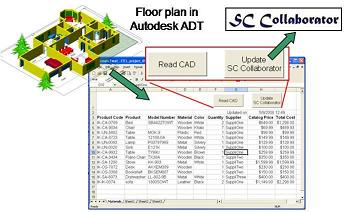
| Home |
| Project Summary |
| Members |
| Project Proposal |
| Presentations |
| Publications |
| Test Case 1 |
| Test Case 2 |
| Download |
Test Case - e-Procurement Among Supply Chain Partners Using Service Oriented PlatformBusiness / Engineering Problem
The value of supply chain integration has been identified in many industries. Integrating supply chain partners helps reduce cost, increase service level, improve responsiveness to changes, better utilize resources, and facilitate decision making. Unfortunately, the construction industry is arguably the least integrated of all the major industrial sectors.
The highly fragmented nature of the construction industry poses a significant challenge to cross-enterprise coordination in construction supply chains. The construction industry is fragmented among participants including general contractors, subcontractors, architects, engineers, laborers, and developers. These AEC companies tend to use a wide range of hardware platforms and software applications for their own operations, leading to the technical challenges in integrating the construction supply chains.
The temporary project-based nature of construction projects also hinders integration of construction supply chains. Since construction supply chains are highly dynamic, the organizational structure changes frequently. It is, therefore, unlikely for project participants to work together long enough on any one project to build enough trust and to share information willingly.
SC Collabortor
The SC Collaborator system can integrate other existing systems and information that are being used internally to support various business operations. This increases the usability of the SC Collaborator system and enables the system to become a part of the IT operations for a company. The SC Collaborator system can also be automated and integrated by external software applications. Internal system and business operations in SC Collaborator can be deployed and exposed as secure web services, which can be invoked and combined easily by many programming languages such as Java and commerical software such as Microsoft Excel through Simple Object Access Protocol (SOAP) messaging.
Test Case
Procurement is an important area of research in supply chain management. Electronic procurement has been increasingly adopted due to its obvious savings in transaction cost and time, its facilitation of inventory management and product standardization, and its enhancement of order responsiveness. However, it usually takes time to configure and establish the communication channels between buyers and sellers. Due to its service oriented architecture, SC Collaborator allows easy and quick integration of system users. This case example illustrates an e-Procurement scenario among interior designers, contractors, and suppliers using the SC Collaborator system. The workflow of activities involved in this scenario is shown below.
Implementation
 In this scenario, suppliers publish their product information on company online catalogs on the Internet or an Extranet. An interior designer working with a general contractor connects to the catalogs, selects the items (such as furniture items), and drags and drops the items with embedded information from online catalogs to architectural design software Autodesk Architectural Desktop (ADT). The designer can then extract the embedded item information from the architectural drawings in ADT to Microsoft Excel. By clicking the Update SC Collaborator button, the item information is submitted to the SC Collaborator system via standardized web service protocol for the general contractor to review.
In this scenario, suppliers publish their product information on company online catalogs on the Internet or an Extranet. An interior designer working with a general contractor connects to the catalogs, selects the items (such as furniture items), and drags and drops the items with embedded information from online catalogs to architectural design software Autodesk Architectural Desktop (ADT). The designer can then extract the embedded item information from the architectural drawings in ADT to Microsoft Excel. By clicking the Update SC Collaborator button, the item information is submitted to the SC Collaborator system via standardized web service protocol for the general contractor to review.
The procurement officer of the general contractor can log into the SC Collaborator system and evaluate the material lists proposed by the designer. After reviewing, an electronic purchase order can be easily generated and sent to the designated suppliers through web services. The supplier logs into the SC Collaborator system and manages the purchase orders it receives (see below). After considering its inventory information and production schedule, which are provided as separate data web services in the system, the supplier makes decision on the items to deliver and responds to the general contractor electronically with a confirmation number. The contractor can obtain the updated item status and purchase order information from the SC Collaborator system instantaneously. For all the products, a timestamp is generated at every change in item status. This information is stored in the system to aid evaluate the performance of business partners and plan the life cycle of each material product.
Contributions
This research presents a prototype service oriented web-based system, SC Collaborator, designed for construction supply chain integration and collaboration. The system provides a single point of access to distributed information, applications, and services among scattered supply chain members. It is modular, flexible, secure, and easy to install and reconfigure, which make the SC Collaborator system a desirable means for companies in the construction industry. The system also allows interoperation among applications because programs written in different languages and operating on different systems can be integrated via standardized web services protocol.
| ||
|
Should you have any comments or suggestions, please contact Jack Cheng at cpcheng@stanford.edu.
All rights reserved. Engineering Informatics Group, Stanford University. |

